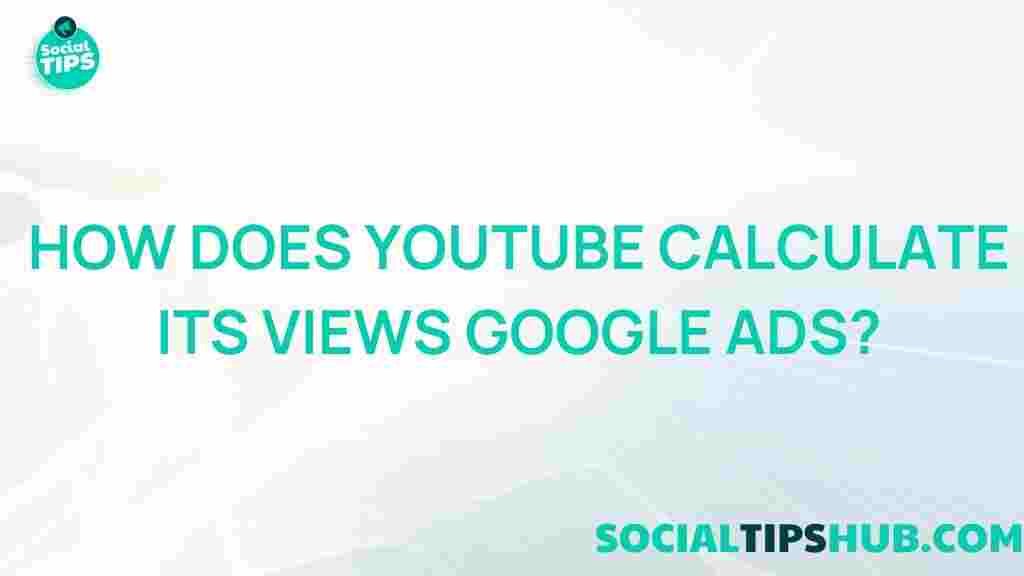YouTube: Unveiling the Mystery of View Calculation and Google Ads
YouTube has transformed the way we consume media, becoming a staple in our daily lives. With millions of videos uploaded and watched daily, understanding how YouTube calculates views and the intricacies of Google Ads is essential for content creators, marketers, and casual users alike. This article will delve deep into the mechanisms behind YouTube’s view counting system and how it integrates with Google Ads to create a comprehensive advertising ecosystem.
Understanding YouTube Views
To grasp how YouTube calculates views, we must first understand what constitutes a view. A view is counted when a user watches a video for a minimum duration. However, the specifics can be more complex:
- Minimum Watch Time: A video view is recorded if a user watches it for at least 30 seconds. This threshold helps ensure that the views are genuine and reflect actual interest.
- Repeated Views: YouTube does not count repeated views from the same user within a short time frame (usually a few hours) to prevent spam and artificially inflated view counts.
- Playback from Various Devices: Views are tracked across different devices and platforms, whether the video is played on a smartphone, tablet, or desktop.
Understanding these criteria is vital for content creators aiming to maximize their view counts and engagement rates. Creators should focus on creating compelling content that keeps viewers engaged for longer periods.
How YouTube Calculates Views
Now that we understand the basics of what counts as a view, let’s break down the calculation process:
- View Tracking: YouTube employs sophisticated algorithms and tracking methods to monitor how many times a video has been played. This includes real-time data analytics that can detect unusual patterns in view counts.
- Bot Detection: YouTube has measures in place to identify and filter out views from bots or automated systems. This is crucial in maintaining the integrity of view counts.
- User Engagement: Factors such as likes, comments, shares, and watch time play a significant role in determining a video’s visibility and how often it will be recommended to other users.
These factors highlight the importance of not just accumulating views but fostering genuine engagement with your audience.
The Role of Google Ads on YouTube
Google Ads serves as a powerful tool for monetizing content on YouTube. Here’s how it works:
- Ad Placement: Advertisers can place ads on videos during the upload process. Creators can choose different types of ads, such as display ads, overlay ads, skippable video ads, and non-skippable video ads.
- Targeting Options: Google Ads provides advertisers with robust targeting options, allowing them to reach specific demographics, interests, and behaviors, ensuring that ads are shown to the most relevant audiences.
- Performance Tracking: Advertisers can track the performance of their ads through Google Ads’ analytics, helping them measure effectiveness and adjust strategies accordingly.
For creators, understanding the integration of Google Ads is crucial for maximizing revenue potential through ad placements.
Step-by-Step Process of View Calculation
Here’s a simplified process of how YouTube calculates views:
- User Interaction: A user clicks on a video thumbnail and starts watching.
- Tracking Begins: YouTube’s algorithms start tracking the view as soon as the video plays.
- Time Monitoring: If the video is watched for more than 30 seconds, it qualifies as a view.
- Data Collection: YouTube collects data on the user’s engagement with the video, including likes, comments, and shares.
- View Count Update: If the algorithms confirm the legitimacy of the view (not from bots or automated systems), the view count is updated.
This process emphasizes the need for genuine user engagement to achieve higher view counts.
Troubleshooting Common Issues with YouTube Views
Despite the robustness of YouTube’s view counting system, users may encounter some common issues. Here are troubleshooting tips to resolve them:
- Low View Count Despite Engagement: If your videos have a low view count despite significant engagement, ensure your video is set to public and not restricted by age or region.
- Repeated Views Not Counting: If your views are not being counted as expected, remember that YouTube limits repeated views from the same user within a short timeframe.
- Understanding Analytics: Familiarize yourself with YouTube Analytics to get detailed insights about your audience and how they interact with your videos. This tool can help identify issues and optimize content.
By being aware of these common problems and their solutions, content creators can better navigate the platform and improve their performance.
Conclusion
YouTube’s view calculation process and the integration of Google Ads are vital components of the platform’s ecosystem. Understanding how views are counted and how to effectively utilize Google Ads can significantly enhance a creator’s ability to reach wider audiences and monetize their content. By focusing on creating engaging, high-quality content and leveraging advertising tools wisely, creators can thrive in the dynamic world of YouTube.
For more insights on maximizing your YouTube presence, check out our detailed guide here.
Additionally, stay updated with the latest in digital marketing and advertising by visiting Google Ads Official Site.
In the ever-evolving landscape of digital media, knowledge is power. Embrace these insights, and let your content shine on YouTube!
This article is in the category News and created by SociaTips Team






